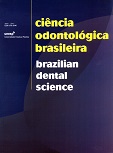Densidade óptica e composição química de resinas compostas
DOI:
https://doi.org/10.14295/bds.2007.v10i4.296Abstract
Verificou-se a densidade óptica de quatro resinas compostas disponíveis atualmente no mercado, bem como a composição desses materiais quanto à presença de elementos químicos responsáveis por sua densidade óptica. As resinas Z250 e Supreme (3M-ESPE), 4Seasons (Ivoclar Vivadent) e EsthetX (Dentsply), foram inseridas em orifícios existentes em 12 placas de acrílico divididas em espessuras de 2 e 4mm. Os incrementos de resina (2mm) foram fotopolimerizados por 40s. Realizaram-se 3 tomadas radiográficas de cada placa com o tempo de exposição de 0,12s. As imagens digitais foram obtidas através do sistema DenOptix. Foram realizadas 3 leituras de cada tomada radiográfica em cada resina no software VixWin, sendo calculada a média dos maiores e menores valores de densidade óptica (em pixels), totalizando 216 leituras. Confeccionaram- se 2 amostras de cada resina para análise dos elementos químicos em Microscopia Eletrônica de Varredura através de Espectroscopia por Dispersão de Energia (EDS). Os resultados foram submetidos ao teste de Shapiro-Wilk, à Análise de Variância, ao teste de Tukey a 1% e Correlação de Pearson. As médias de densidade óptica (pixels) em 2mm e 4mm, respectivamente, foram (valores seguidos de mesma letra não diferem estatisticamente entre si): Z250 = 171,17a e 199,58x; Supreme = 167,78a e 195,30w; 4Seasons = 176,32b e 208,50y; EsthetX = 190,85c e 213,56z. Os maiores valores foram obtidos pela resina EsthetX, nas duas espessuras avaliadas. Com base nos resultados encontrados concluiu-se que não houve correlação entre os valores médios de densidade óptica das resinas testadas e o percentual em peso de elementos que lhe conferem esta característica.Downloads
Downloads
Published
How to Cite
Issue
Section
License
Brazilian Dental Science uses the Creative Commons (CC-BY 4.0) license, thus preserving the integrity of articles in an open access environment. The journal allows the author to retain publishing rights without restrictions.
=================




























